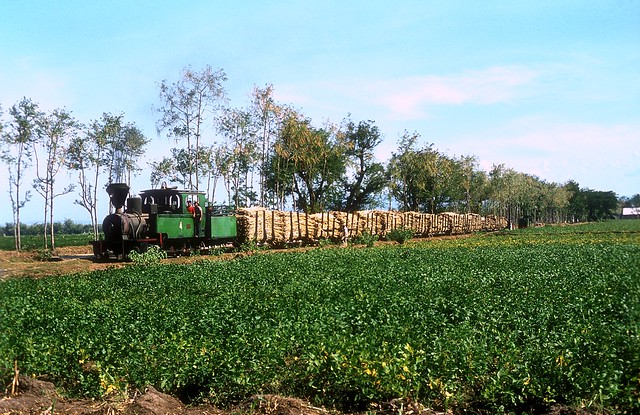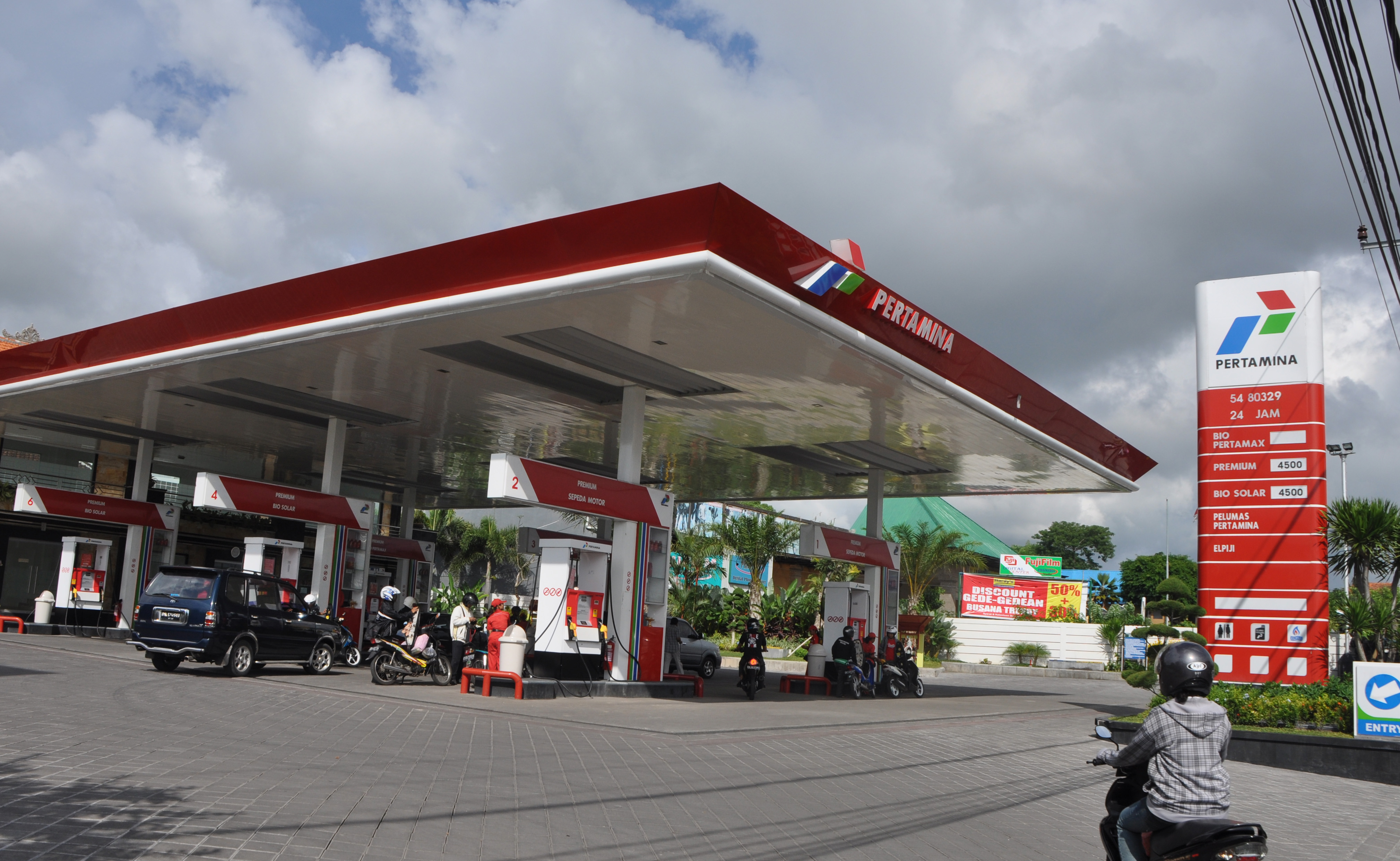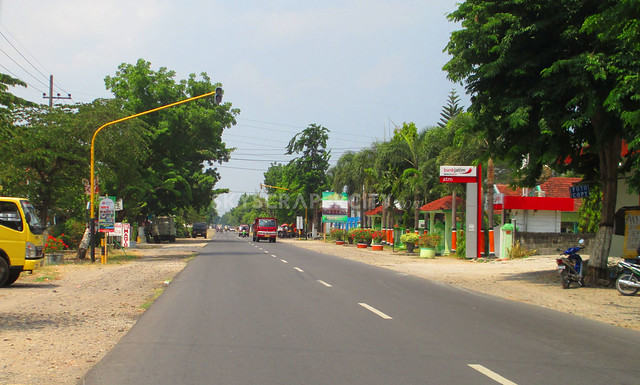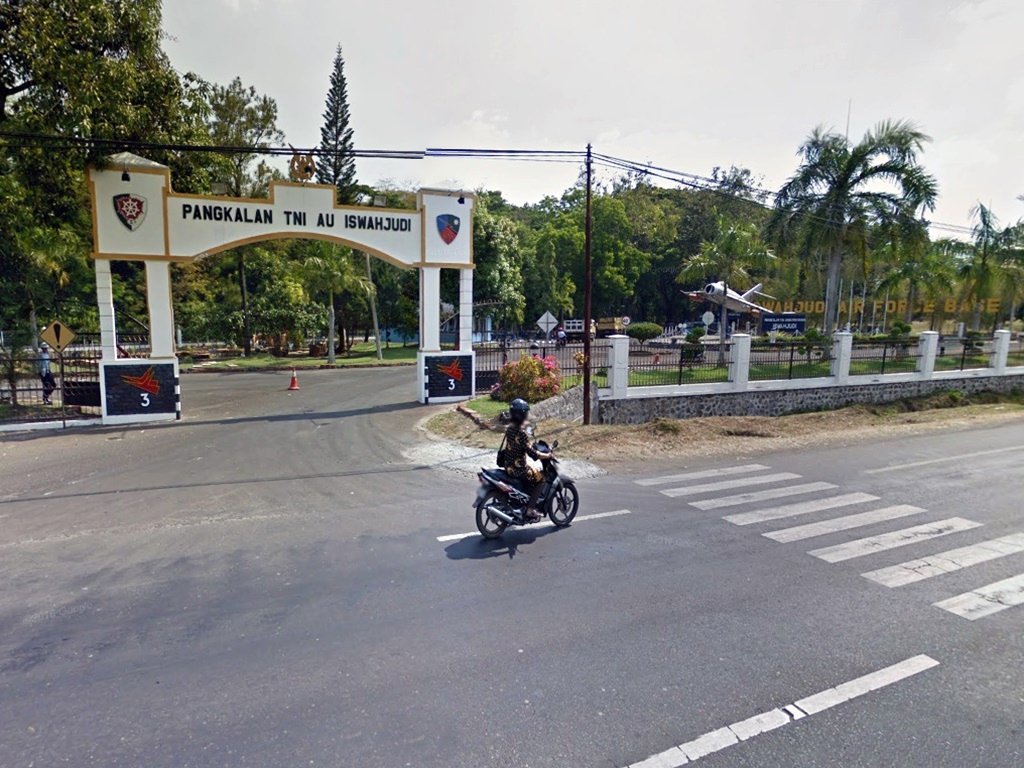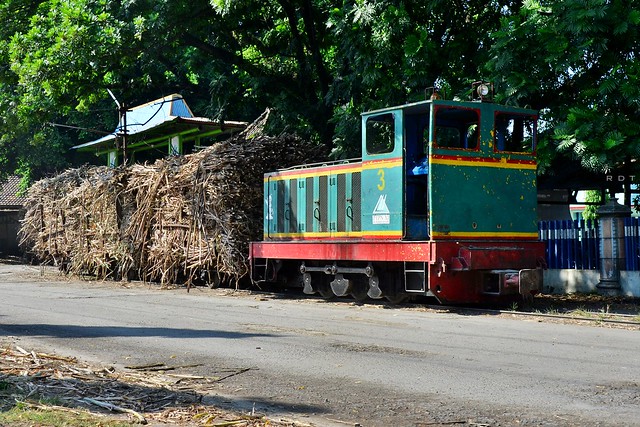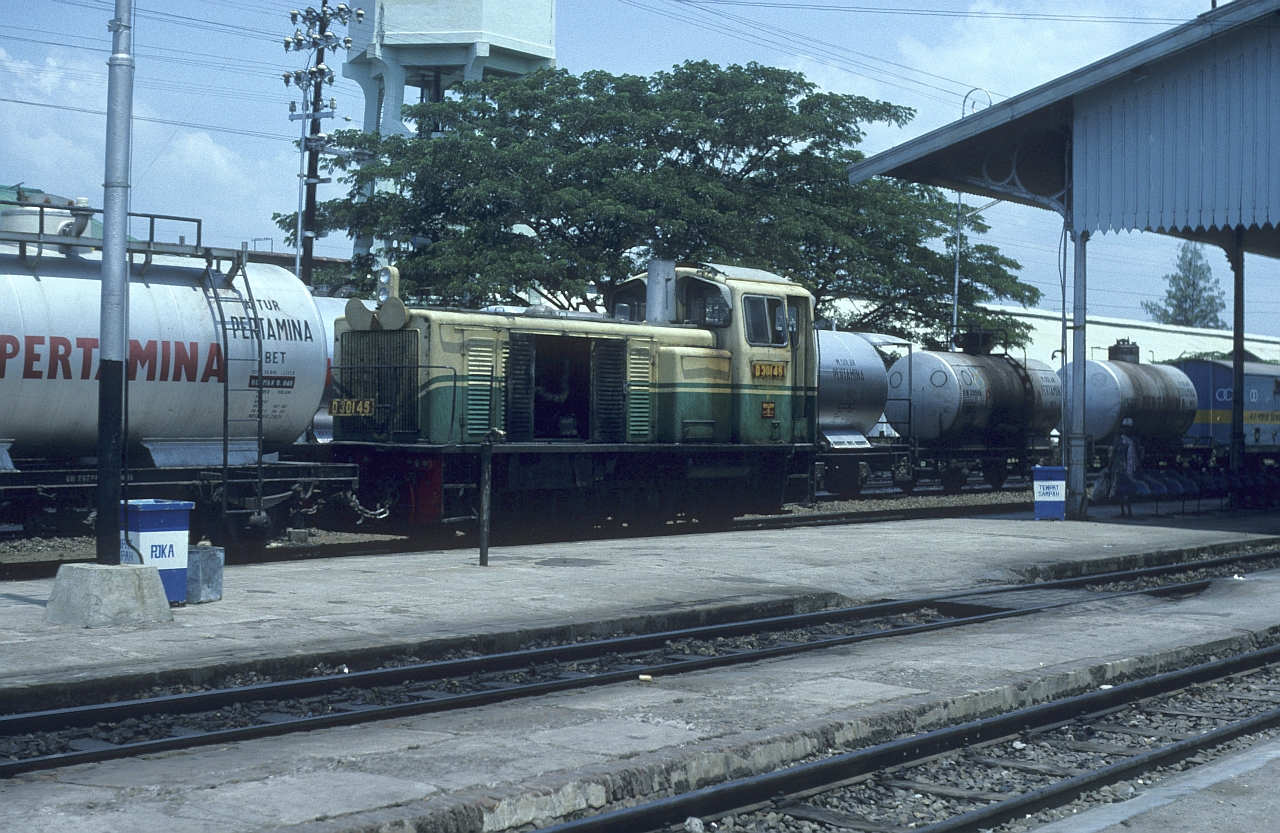I woke up to a beautiful morning on 1st September 2022. It was a sunny day and definitely a good weather to start today’s tour.
Normally, I would feel very excited on taking a railway tour. And the fact that I would use the new toll way to speed up the journey, would have thrilled me.
But the effect of the depression caused by recent pandemic and some domestic problems seemed to hinder myself from fully enjoying today’s tour. I still felt that there was an unexplained mental burden that preventing myself from feeling good today.

Nevertheless, I was very much ready to start the day’s tour.
On today’s itinerary, we will go Madiun where we will see some steam locomotives in action in sugar mills around the town. The chosen one are Pagotan and Purwodadi as these mills do still operate their steam locomotives on regular basis during harvesting season.

These mills are what is left of what was once a giant interconnected network of narrow-gauge sugarcane railway lines that encircled the town of Madiun. Back then, during sugarcane harvesting season, it was virtually possible to see steam locomotives hauling sugarcane wagons (both empty of loaded) in every part of the town.
But their decline began when the sugar mills began to abandon their field lines, and even retiring their steam locomotives. The last to close down their field lines (according to what was documented by foreign visitors) was Rejosari at the end of 1998 season, although some people told me that Kanigoro and Rejoagung may ran their field lines up until 2005.
Now all sugarcane train operations are limited to inside the mill compound. What they do now are just shunting wagons between road yard and the mill. All sugarcane haulage from the field is now done by road trucks. Some mills are even in the process of abolishing their railways completely!

After departing from my house, I went to pick Peter up from his hotel in Manyar Kertoarjo district.
There was a bit of drama when I was going to pick him up, and it actually goes back to the night when we returned back to Surabaya.
My car’s fuel reserve was half full when I arrived in Surabaya. I definitely needed to fill up my tank before starting the tour to Madiun on the following day. But when I was about to refuel my car (after I dropped Peter in his hotel), I found that virtually all of the state-owned Pertamina petrol stations in Surabaya were full of queues. Some even stretched for hundreds of meters!
Apparently, these people were duped by the gossip which said that fuel price would be increased at midnight. Peter did witness the commotion as his hotel was near one petrol station.
“That queue looks crazy! What they’re lining up for?” Peter asked. “I think the fuel price will goes up tonight. If that’s true, they’re definitely trying to get the best deal before the price goes up” I replied.
By the morning, it turned out that the fuel price remained the same as the day before. Obviously, those who lined up last night were pretty much conned. The lack of the queue meant that it was easy for me to fill up my tank. Once the fuel tank topped up, and payment settled, I head to Swiss Bel Inn Manyar to pick up Peter.
When I entered the hotel, I found that Peter had already waited in front of the lobby. He was very much ready to go, and had all of his equipment ready. He also looked fresher as he had had shower.

“Good morning, Peter! How are you?” I greeted him as he approached my car. “Great Bagus! And you?” he replied and asked back. “Well, I’m good! Shall we start the tour today?” I continued. “Yeah sure!” Peter replied.
We quickly got onboard my car. And before long, we departed from the hotel and start traveling to Madiun.
Since we weren’t in real hurry, instead of traveling through bypass road to access the toll way, I decided to travel through the inner-city area. I wanted to show Peter on how does Surabaya city looks like. He was really keen to see how does cities in Indonesia looks like as it was his first visit to the country.
The traffic in Surabaya in that morning was largely busy, but not jam packed. It wasn’t too difficult for me to negotiate it, and before long we finally reached Waru where I entered the toll way in here.
Driving along Surabaya roads was akin to eye opening experience for Peter. Although the city wasn’t the first that he visited in the country, it gave him an understanding on how chaotic Indonesian road is. The traffic is nightmare, and near misses are common occurrence.
“I can’t drive in here. The traffic is super crazy! The bikes, the cars, everything seems to be driven by lunatics! I’m amazed that no accidents took place despite the frequent near misses” Peter commented after seeing the traffic conditions.
Although I’m well-adjusted with the chaotic traffic of Indonesian roads, in reality I detest it. And motorcyclists are the biggest offenders on our road. They often swerved into someone’s path, running the red light, traveling on the wrong way casually, or even using mobile phone while driving! To make the matter worse, most of the time they get away with their crimes!
But thankfully, all of those dramas ended as we entered the toll way. Since motorcycles and slow drivers are banned from here, it means we will have enjoyable drive all the way to Madiun. The toll way is part of Trans-Java motorway which was opened in 2018. With its opening, it enabled drivers to avoid crowded and often jammed roads between Surabaya and other cities in Java.
The drive to Madiun on the toll way was largely peaceful and uneventful. Although I’ve travelled on the full length of Trans Java toll way, it was actually the first time I drove by myself beyond Mojokerto. Previously, when driving, I would conclude my journey in Krian or Mojokerto as I would do trainspotting in those places.

Although traveling through toll way enabled me a more peaceful and hassle-free drive, the whole experience can be quite boring and even tiring. The lack of variety (and admittedly drama) made me less alert.
And driving on the toll way can be quite painful too. My right foot ached because I had to constantly press the throttle pedal for prolonged period, at certain angle too. This was done to maintain speed of the car. But the way I put my foot apparently strained my muscle, and this in turn caused some aching.
During the drive, me and Peter exchanging some stories too.
Peter explained his story on how to deal with State of Victoria’s very strict road rules. He said that Victoria seems to have the strictest rules when compared to other Australian states. The local authority even goes extra miles to ensure that they’re able to detect even slightest mistakes, and punishing road users for that.
“In Australia, you can’t use your phone while driving. They have invented a kind of surveillance camera which can detect the presence of phone around the driver. Even if you put your mobile phone on your lap, you will still be fined for that! And the amount that must be paid could go up to $600!” Peter told his story.
I also told my perspective in regards of difference of road rules and its law enforcement between Indonesia and Australia. As an Indonesian who lived in Australia, I gave him some insight that surprised Peter.
“You know, in here the concept of rights-of-way is not well understood. It’s the reason why people swerved into your path, and got away with it. And also, tailgating is not considered a traffic offence in here. I know, in Australia you’ll be fined for that. Also, while traveling faster than speed limit is major problem in Australian road, in Indonesia…especially Java… the most common speed related offence is they drive too slowly. Way beyond minimum speed limit!” I told my story to Peter.
We also discussing the difference between the way Indonesian and Australian perceived car preference. Although Toyota is the most popular brand in Indonesia, the marquee is derided in Australia!
“The problem with Toyota is because they have such a poor customer service!” Peter explained. “Why is that? What’s the problem with Toyota in Australia?” I asked Peter. “Once they sell defective cars in the market. When the public complained, they gave compensation. But still, they refused to acknowledge that they’re at fault. It’s the reason why Toyota isn’t particularly popular in Australia” Peter explained again.
His story suddenly reminds me of my days when I was in Australia. At one time I was an avid enthusiast of motor racing. And the side effect of that was I frequently looking at motor vehicles advertisement, including second hand market. Mooning for the dream car or motorbikes that I never purchased. Consequently, I developed awareness of car brand popularity in Australia.
Although the title of the most popular brand (not in term of number sold, but by brand reputation) changes over the year, basically the car preference in Australia and Indonesia are different. Back when I was in Australia, it was either Holden or Ford, due to their involvement in local touring car championship.
“My car is a Kia. It’s a nice Korean car brand. They’re selling good products at cheap price. Their customer service is excellent too. Mine is a powerful sports car produced by the company, and I really love to use it. I regularly drove my car to work” Peter told his story.
It can be said that the toll way enabled us to have a smooth and seamless journey to Madiun. So much that on some occasions, Peter fell asleep as the journey was very smooth.
Slightly more than 2 hours after I picked Peter up from his hotel in Surabaya, we finally made it into Madiun. It was amazing that the journey between two cities is now can be done with such ease. Although I had to pay extra for the toll entrance fee, the new toll way enabled me to save time and obviously fuel.
After paying the toll fee (by way of using tap card), I exited the toll way and entering the ordinary highway.
Once we reached the highway, I realize that there’s still a significant distance between this place and the entrance of Madiun. The place is apparently well away from even Rejoagung sugar mill (the place that is often considered as the northernmost border of the town).
Despite the fact that we have arranged the itinerary beforehand, Peter gave me some liberty on which places to go first. His main goal is to see the fireless locomotive at Pagotan sugar mill. But he’s open to the idea of seeing everything else while we’re in Madiun, as long as the main goal is achieved.
I was thinking of going to Purwodadi sugar mill. The place had consistently been known as one of the last places in the world to see steam locomotive at regular work. Although beyond 2020 they stopped using their steam locomotive, by early 2022 I’ve seen report and even video that now they’re resuming steam locomotives operation in here.
And I was hopeful that we could see such thing again today.
“What do you think if we go to Purwodadi sugar mill first? I heard that now they’re resuming steam locomotives operation in the mill” I asked Peter. “Sure! Why not? Let’s go there!” he replied.
From the intersection near the toll gate, there’s actually a shorter route that goes west from here and actually bypassing the downtown of Madiun. But since I want to introduce the town to Peter, I decide to take longer route through the downtown and Maospati. This route is the common route that I took to go to Purwodadi sugar mill from Surabaya, especially in the days before the toll way opened.
It also opened my eyes that apparently there’s a lengthy drive between the toll gate and the town. And dealing with the traffic was quite hair raising too. It’s reminiscent to my early days of running Java Steam & Sugar tour, where I had to drive for almost the 2/3 length of Java Island just to see steam locomotives.
After several kilometres of driving, we finally reached the entrance monument of Madiun. This monument is located right on the northern perimeter wall of Rejoagung sugar mill. Back in the past, there was a Mallet steam locomotive plinthed on display in here. The locomotive is the only surviving locomotives from what was once large fleet of steam traction of Rejoagung sugar mill.

But in 2020, for mysterious reason it was removed from its position and placed in a shady place on the streetside near the mill. Unfortunately, the locomotive also suffering some form of vandalism since it was relocated to the current place. Its future also seems to be in limbo too.
Just after we passed Rejoagung sugar mill, Peter was treated by the sight that amazed him: the street running. Madiun is one of very few places in Indonesia, or even world, to see street running railway line. The branchline that serving the fuel depot in Madiun is the place where one can see mainline locomotive running side by side close with road vehicles.
“Wow! This is so cool! I’ve never seen something like this before! Is the line still in use?” Peter asked. “Yes, it’s still in use. Once a day there’s a train traversing the line” I replied. “Cool! I hope that I can record its movement” Peter commented excitedly. “I think we will see one this afternoon. Hopefully we can get it” I added.
The town of Madiun was quite busy on that day. It was midweek, and people still going to work. Yet, the traffic was fairly manageable with no significant congestion. So, passing the downtown area was pretty easy. If there were shortcomings, it was when I took the wrong turn. But it was easily fixed.
“This town is really amazing. Compared to Jakarta, this town is much tidier. I think it would be an exciting place to visit” Peter commented upon seeing the downtown Madiun.
We weren’t staying for long in downtown Madiun. A few minutes later, we exited the town and head to Maospati. The journey was slightly longer one, but generally straightforward.
As we approached Maospati, I told Peter that we were about to pass one of the largest Air Force bases in Indonesia. Peter, who also has interest in aviation, was curious about it. “Wow cool! Are we going to see some fighter planes?” he asked. Knowing that the base is heavily fenced and chance of seeing active fighter planes are slim, I said: “Well, we would only see them if we’re lucky enough.”
Iswahyudi Air Base is a large military air base owned by Indonesian Air Force. The complex is vast, so much that it virtually occupying almost the whole district of Maospati. So much that whenever the name “Maospati” mentioned, people would think of this particular air force base and its tenant fighter planes.
And the base is also known as the home of Indonesian Air Force’s most advance fighter planes. It’s well known as the main base of F-16 Fighting Falcons. And historically, it was also used as the base of the MiGs, as well as Tupolev bombers.
One of those old MiGs is now preserved at the corner of the road, near the Maospati bus station. Peter was amazed when he saw the MiG-17 which is placed on the pedestal, and took some photo of it.
Beyond Maospati, we went straight north to Purwodadi sugar mill. The journey to this mill was uneventful, and before long we finally arrived at the mill’s road yard where sugarcanes are transferred from trucks to train, to be hauled by the trains into the mill.
In my previous visits between 2014 until 2017, whenever I came to here (whether with or without guests), I would always be greeted by the sight of steam locomotives who were used to for sugarcane haulage. If I was lucky, I would have seen them working hard hauling the train from the road yard into the mill.

But on this visit, I was really surprised to see that there was nothing other than loaded wagons. The yard was devoid of the sound of engines. Although it was the height of harvesting season, I didn’t see any steam locomotives in the yard. There weren’t even the diesel locomotives to be seen! It was incredibly quiet.

Even the run-around tracks adjacent to the yard, which was used for locomotives to bypass the loaded sugarcane wagons to reach the back of the yard, looks grassy. Obviously, it hasn’t been used for long time.

The quietness was occasionally punctuated by the tractor’s activity. How sad! Now this vehicle is essentially the only mean of motive power used in here! Gone were the days when steam locomotives would puff or even roar in here.
Although I’m aware that the regular steam locomotives working ended at the end of 2020 season, in early 2022 I was told that one of the steam locomotives was back in service. And it wasn’t just for chartered run, but for regular works!
But today, we were really unlucky.
While we were browsing, suddenly a middle-aged woman approached us. She apparently noticed our activities in taking train pictures, and seems to be familiar with railway enthusiasts. She did give us some information about the current railway operations of the time.
“You should have look at the back there. It’s where they transfer the sugarcanes from the truck” the old lady told us. “No thanks. We’re here to see the steam locomotives” I replied. “Oh, are you looking for the locomotive? Yesterday it was still used in here. It hauled the sugarcane wagons between here and the mill” she continued. “Oh, is it? The steam locomotive? Do they use it until now?” I asked curiously. “Yes, I think” she replied.
But then she also added another unpleasant story: “I did saw the steam locomotive at works yesterday. But then suddenly it broke down near the office over there and the crew surrounded it. They tried to fix it, but then they just ran the locomotive inside and I never saw her again for the rest of the day.”
“But does it run again today?” I asked her again. “I don’t know. I haven’t seen the steam locomotive today. Maybe they’re still warming it up.”
The lady herself looks rather strange to me. While the locals would normally speak in thick Javanese accent, she spoke in standard Indonesian language. In fact, she hardly looked like locals. But then, she insisted: “I was born and grew up in Madiun! I know the place well. But I used to migrate to Jakarta when I was young. I used to work there for more than 20 years. But when my kids grow old, I decide to return back to Madiun and lives here.”
But when I found out where she lives, I was saddened. She actually lives in a shabby looking shack just outside the road yard’s perimeter wall. Her husband is opening a motorcycle washing business. I guess she is just one of those unfortunate people who didn’t do well when trying their luck in Jakarta.

We tried to get some information from the workers in the yard. I asked one: “Excuse me sir, is the steam locomotive running today?” He replied: “No, not that I know. I haven’t seen it at work today.”
“Is it possible to get inside the mill? Who knows if the steam locomotives are there. I don’t mind if I have to pay something just to get inside” Peter asked. “I think you can. I don’t know whether if we can go in through that way because the chance is 50-50. I’ve been to another mill where me and my guest was flatly rejected, even if we’re willing to pay” I answered.
Since there’s nothing to be seen in here again, we decide to move into the mill. Although it’s still a same complex, there’s quite a significant length of drive between the road yard and the mill. And it would have taken a very long time to walk!
The reason why I took him to the mill is because there’s a theme park on the northern corner of the mill where visitors could go in and looking at the yard’s activity. And all without need to arrange permit letter from the headquarter.

But upon arriving, I was shocked to see its entrance gate is closed shut. And even more saddening is the fact that the theme park itself has been abandoned. Overgrown grasses began to cover what was once food vendor booths and guests’ tables. The place is very much derelict now.

Obviously, our chance of bypassing the bureaucracy in legal way has officially been terminated. In the past, by wandering around the theme park, we could have a look at the activity in the railway yard. Even sneaking into the locomotive shed was possible!
Unfortunately, now the only way to get inside is by asking permission; which can be a hassle.
Thankfully, not everything was lost in here. Peter took the opportunity to look and photograph the old steam locomotive which is displayed in front of the name sign of sugar mill. The locomotive is one of Purwodadi’s steam locomotives who was retired early. Unlike many of its peers who no longer works, the loco is lucky enough to be displayed here.

From here, we go to the level crossing to see the wagon shunting activities in here. The place is normally known to see locomotives hauling sugarcane wagons into the mill. At the height of steam locomotives era (which wasn’t too long ago), it really was a great place to record the locomotives working hard in here.
But since the tractor took over the motive power duty in here, the operations become somehow strange.
Now what the tractor do is pushing a short train of loaded sugarcane wagons across the road. And those wagons aren’t coupled, so by the time it passed the level crossing the wagons would be detached from the train and rolled down the gradient into the mill. And right inside the mill, someone will couple those wagons to form a train which will be hauled by a diesel locomotive.

Even the tractor itself didn’t cross the road at all!

While we were enjoying the sight, suddenly one overreacting security personnel approaching us. “Excuse me sir! You can’t take photos in here! You must get permission from the office!” he shouted to us. “But we’re in public area! We never need permission to photograph anything in here before!” I protested. “I don’t care! You must get the permission from the office now! Get in your car and follow me!” he commanded me.
It was quite a rude and unpleasant treatment! I never had something like this before. Normally, we could do trainspotting in here and even in the yard without too much troubles. Besides, the whole place is essentially public area.
But this time we decide to follow him, so we boarded our car and followed his motorbike.
“Is it possible to escape from him? Besides we’re riding car and can easily outrun him?” Peter asked. “It is possible, but….” I starting my reply. “But what?” Peter asked further. “You said that you want to get inside. Who knows if we can use this opportunity to get into the locomotive shed?” I explained to Peter. “Hmm, yeah! Sounds like a good idea!” Peter accepted my idea.
The zealous security guard guided us into the main entrance door of Purwodadi sugar mill. Upon entering, he directed us to park the car in the corner near security post. “You wait there while I talk with the management!” he commanded us.
We took a seat in front of the guard post while waiting for the security staff. Along the way, we were treated by the sight which is the reason why Peter didn’t fly his drone: apparently there were fighter planes maneuvering above. Some of them were seen deploying their landing gears in preparation for landing in Iswahyudi Air Base.
Purwodadi sugar mill is located under the landing path of airplanes who wanted to land at Iswahyudi Air Base from northerly direction. Sometime the sound of passing airplanes could interfere with the sound of steam locomotives, especially if they flown slightly lower.
Most of the planes that we saw were KAI FA-50 fighter planes, which looks almost identical to F-16 unless it has twin engine intake. But once we saw a pair of F-16 flying above. Although they were flying at lower throttle setting as they were approaching to land, they were really loud!
In addition to the fighters, we also saw large diesel locomotive shunting some wagons near the entrance door. It’s unique sight indeed, and it would have been lovely if we could photograph it. Alas, since we’re being barred from taking photo, we decide to forego it.
Several minutes later, the same security staff returned back. This time he is accompanied by one management employee in grey safari dress. The management staff asked me: “So where are you from?” I replied: “We’re from Surabaya. We just wanted to see steam locomotives in here, possibly in the garage if we can.”
Normally they would suspect that a person who traveled with foreigners like as a tour guide from a travel agent. But somehow, he didn’t make a fuss about that and giving us permit directly.
“Okay, I can allow you to see the locomotive garage. But you only have 15 minutes to do so. Do you agree?” he asked me. Seeing it as golden opportunity, I decide to accept his offer. “Okay sir, it’s okay for us” I replied him. “Good! Now you follow the security staff. He will guide you to there, while you drive your car” he concluded.
After that we reboard the car, and then I drove to the back of the mill compound trailing the security guard who guided us into the locomotive shed. The shed is located at the back of the mill, and quite near to the entrance door where trains from road yard (or field lines in the past) entered.
It was the second time I came to this place, and first with my own car. My first visit to this place was back in 2018 during a Java Steam & Sugar tour with Paul and Hayden.
Upon arriving at the shed, we were greeted by the sight of steam locomotive number 16 parked in front of it.

She’s here! Apparently, she’s in cold conditions and definitely will not run for today. We even had no idea whether if she will run again for the remainder of the harvesting season.
The pesky security guy who pestered us in the level crossing suddenly changes his mood. From the previously stern and hostile, he suddenly turned jolly. He seems to be really happy to be able to “drag” some foreigner inside. I think he was just an opportunistic person who tried to extricate some money from foreigner. Although admittedly, we hadn’t spent any money for administration fee in here yet….

Inside the shed, we could see several steam locomotives being parked inside. Some of them featuring faded paints, which denotes that they haven’t run for decades.

But there are also some steam locomotives which are recently painted in smart dark green livery.

These locomotives are those who were used to haul wagons in recent times.
In fact, I did saw them when they were at works in 2014 and 2015. It was really memorable moment back then. So, seeing them cold in the shed was a bit disheartening.

Although none of the steam locomotives were running, Peter was really happy to be here. He was like a jolly kid in a candy shop. “Boy! This is really lovely!” he exclaimed.

While browsing, I also came across the former amusement train coach parked in one corner of the shed. I remember, on my previous visit, it was still used for amusement train around the mill compound hauled by diesel. But since the closure of the theme park, it’s sadly no longer in use.

Once Peter is done with photographing in here, it was time for us to say goodbye and head back to Madiun before going to Pagotan sugar mill. The security guys (including the overzealous one who intercepted us) just let us go without requesting any additional things.

I drove carefully as I navigating my way out of the mill’s compound. Once we reached the gate, I was really surprised that they opened the door and let us go. We gleefully exiting the mill compound when we realize that our visit at Purwodadi was essentially free!
“That was great! The best experience I’ve ever had so far! I’m really happy to be able to see all of those steam locomotives!” Peter said in satisfied mood. “Oh yeah! Well, I’m sorry if I can’t show you the live steam locomotive” I commented. “No, that’s okay. Just seeing the steam locomotives itself are really great!” Peter said in satisfaction.
“I guess our visit to Purwodadi would have been much even better if that rude security guard didn’t bug us” I said. But Peter delivered surprising comment in regard of this. “He’s not the worst guy I’ve ever came across when I hunt steam locomotive. In China, I was handcuffed for taking train pictures!” as Peter retell his somewhat dark past of trainspotting.
“Really? Handcuffed?” I asked in shocked mood. “Yeah!” Peter replied. “Why is that? Why do they have to arrest you?” I asked Peter again. “Because they accuse me of public nuisance and spying!” Peter explained. “It’s China, I guess. It’s typical of authoritarian countries” I commented.
We returned back again to Madiun to have a lunch. It was around midday, and our stomach was pretty hungry. The town does have variety of great culinary menus, but Peter wanted satay. “I want satay! I really love satay! See if you can take me to the finest satay restaurant in town” Peter asked.
Although Java itself has variety of satays, in Madiun there is one type of satay that is well known of: Ponorogo satay. This variant of satay is originated from the town of Ponorogo, which is located several kilometers to the south of Madiun. Although the town itself was out of reach, thankfully in Madiun itself there are some restaurants that sells this type of satay.
One of the restaurants that I know is H. Tukri Sobikun, which is located across the road from Transmart Madiun. We ordered two portions of mixed satay, which came in chunky peanut sauce. They’re really tasty indeed! Our calories that we burnt in Purwodadi sugar mill was pretty much replenished here!

After we finished our lunch, we resumed our journey today. Once we returned back to my car, we head south to Pagotan sugar mill.
While driving, we were wondering whether if our journey would be successful or not. “Do we need to go to the management office first when we came there?” Peter asked. I was wondering about that too. But then I delivered my idea: “Normally, if we want to see trains without the bureaucracy hassle, we do it from the level crossing in the south. In the past, when I took tourists without official permit, we’d go to this place. See if we can see the trains without troubles.”
Upon arriving, we were greeted by the sight of road yard packed with loaded sugarcane wagons. There were even some diesel locomotives parked in there too. We definitely going to see some actions today!

And it didn’t take long before finally a moving locomotive turned up.

Apparently, it’s the rare Orenstein & Koppel diesel locomotive. Although the company have produced many steam locomotives for industrial purpose in Indonesia, very few of their diesels are in this country.

We waited for some time in the yard, waiting for the steam locomotive to come out and start hauling the sugarcane wagons into the mill. At that time when we arrived into the place, the steam locomotive was nowhere to be seen.
In order to ensure that our visit will not be wasteful, I asked one of the mill’s employees who was relaxing in one makeshift gazebo in one corner of the road yard. “Excuse me sir, is the steam locomotives are running?” I politely asked him. “Actually, there are 2 of them inside. They will come out to haul the wagons when we have sufficient loads in the afternoon” he replied.
But sensing our true intention, he asked: “You guys wanted to see the steam locomotive, right?” I replied: “Umm, yeah…” He then continued: “I’ll tell you what. Just meet my supervisor. Tell him that you want to see steam locomotive running. Don’t forget to give him sufficient tip money. He will help you.”
I followed his direction and met the supervisor. Despite of his senior rank, surprisingly he was a young person in late 20s/early 30s. “Excuse me sir, may I ask your help?” I asked him. Before he replied, the employee who directed me to see him said: “He and his tourist friend want to see the steam locomotive. Ask them to bring it here!”
The supervisor promptly opened his phone and then talking to someone at the other end of the line. He then said: “Just wait. The steam locomotive will come in a few minutes.
And true to his word, suddenly a sound of steam whistle can be heard coming from inside. Minutes later, we see the steam locomotive gradually appeared and then crossing the street before arriving into the road yard. Seeing her arriving was like watching a celebrity coming into a party.

Although I’ve seen steam workings in Pagotan before, this sight was really fabulous.

“Okay buddy! Just run the locomotive back and forth so this tourist can record the working!” the supervisor commanded the train driver.
Without delay, he began to move the locomotive. First it went backward before going forward, and then he stopped the locomotive just before the level crossing. I think he did that twice.
Peter was really happy with what he got. “Wow! This is awesome! I’ve never seen fireless steam locomotive like this” Peter happily said as he was busy recording the movement.
After the driver completed the run, the supervisor asked us: “What do you think? Are you guys satisfied with the running?” Since it was Peter who had the true business in here, I asked him anyway. “What do you think, Peter? Is it enough, or do you want more running?” I asked him. “One more, please!” Peter replied. And the driver delivered what was requested.
Before we conclude the photo running, the mill employees offered us to ride the locomotive. Of course, we gleefully accepted his offer and before long we were over the moon as we enjoyed the ride onboard this geriatric steam locomotive.

Since the locomotive is now fireless, we didn’t feel much heat in here. The absence of firebox meant that we weren’t exposed to any heat or whatsoever.
While we were riding steam locomotive, I also had some conversation with the train driver. “You know, after this working shift ended, I will have to go to work driving truck to Surabaya and Jakarta” the driver told me. “Oh really?” I asked him. “Yes, I also do drive trucks in addition to this. It’s to make my ends meet” he said.

His explanation does make sense. Since the demise of Pagottan’s field lines network in 1998, train drivers have very little thing to do other than shunting wagons between the road yard and the mill. And seems that they’re paid for too little, so much that they have to take side jobs like what is done by our locomotive driver.
Once Peter is satisfied with the steam locomotive’s photo running session, it was time for us to continue. After paying the tips to the mill’s employee, we return back to our car and head back to Madiun.
We were really satisfied with our visit at Pagottan. The mill’s employees have been very friendly and accommodating to our demands. And even better, we could even ride the steam locomotive too!

From Pagottan, there is one more thing that we wanted to do in Madiun: recording street running activity near Madiun station. The fuel train from Surabaya would normally be shunted through the main street in front of INKA plant into the nearby fuel depot. Such activity is truly a sight of behold due to its rarity.
And I believe by showing this to Peter, it would have made his journey much even more worthwhile.
Upon arriving at Madiun, I drove straight to the INKA plant. It was the first time I came to INKA after a decade, and I’m really surprised by the number of changes that took place in this place.
Now, there’s a museum and guest area located at the front of the premises. In here visitors can go inside without any need to arrange prior permit.

The museum occupies the former administration building that located inside the colonial era buildings. Inside, there’s café as well as variety of model railways replica of rolling stocks that were produced by INKA.

They also displayed many historical railway artifacts that were once placed in storage at the back of the factory.

Some of them were dating back from the time when the place was a steam locomotive workshop.

We waited in the place, and at around 3’o clock in the afternoon the train that we’ve been waiting for had finally arrived. It was a loaded petrol train from Surabaya which was shunted by CC204 05 locomotive.
Seeing the train sharing the same road space as motorcycles and cars was indeed a unique sight. I was so preoccupied in recording its movement that I didn’t have time to photograph it.
“That was so cool! I’ve never seen stuff like this before. It’s just amazing!” Peter told me after he successfully recorded the movement.
Unfortunately, his joy suddenly came to an abrupt halt when he accidentally dropped his video camera. “Oh no! My camera!” Peter shouted in anger as he witnessed his expensive Sony Handycam laying in the asphalt.
He picked up his video camera, and upon inspecting apparently its image stabilizer system seemed to be damaged. But overall, it was still in running conditions. “Oh well…I think I’ll try to fix it when we back to Surabaya” Peter commented upon seeing his camera.
Nevertheless, despite of this incident, we were able to record when the locomotive running light engine back into the station.




After that, we crossed the track and exploring the area to the south of railway track.

The first thing that we saw was the steam locomotive number C26 06.

Although displayed in Madiun, during its last decade of service it was actually operated in Kediri-Pare-Jombang tramline which is well away from Madiun. It only came to Madiun when it was retired.

Another thing that attracted Peter’s attention is this old Krupp shunter diesel, which is now displayed in front of State Railways’ Madiun regional division office.

The locomotive was the main shunter in Madiun station. And before the branchline to fuel depot in front of INKA was upgraded, this locomotive was frequently used to shunt fuel wagons into that depot.
But what makes Peter interested is the fact that the locomotive features coupling rod. Although the item is commonly found in steam locomotives, it was the first time for Peter to see such thing.
Alas, the view of its wheels are blocked by signage. We tried to photograph it from the inside, but unfortunately the security forbade us to go in. So, we ended up taking picture from the only permissible angle: from the outside.

Once we finished with our business, it was time for us to head back home to Surabaya. Upon returning back to INKA, we hop onboard my car where I promptly drove out and then go directly to the Madiun toll gate in the north.
During a drive back to Surabaya, we had some conversations. “That has been a fantastic day! Thanks, Bagus for showing me around” Peter thanked me for the effort. “You’re welcome, Peter. Thanks for trusting me to provide you the service. I just hope that this visit will give you a great memory” I replied. “Oh yes, it will! I’m glad that I’ve get many photos and videos. But the steam locomotive in Pagottan was a real legend!” he concluded.
Indeed, I’m very happy that this short railway tour with very little preparation to be made, has been a successful one. It truly marks the return of the favourite tour in my business. Although it only lasted 2 days, it runs in the same fashion as the other Java Steam and Sugar Tour where it involves chasing sugarcane trains in field lines, hiring steam locomotive, and even riding it.
It’s really good that I’ve finally return back to business.

THE END!

